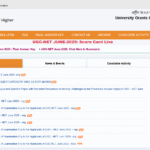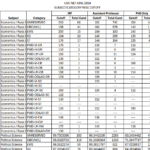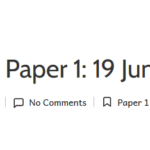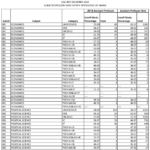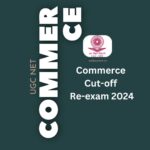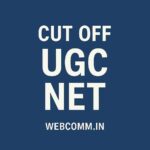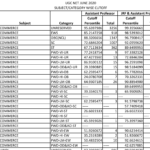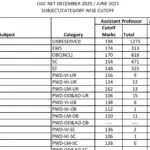BUSINESS ENVIRONMENT
Multiple Choice Questions
More MCQ related to UGC-NET Paper-1

- The term business environment refers to …….. factors which impact functioning of a firm
a) External factors c) Internal factors
b) Management related factors d) Internal and External factors - ………are generally considered as controllable factors.
a) Internal factors c) External factors
b) Cost of production d) None of these - Factors which are beyond the control of a business are called…..
a) Supply c) Demand
b) Profit d) External factors - Marketing intermediaries are categorized under……. Environment.
a) External c) Macro
b) Micro d) Remote - Value system followed by the management of a firm as certain influence on its…….
environment.
a) Internal c) External
b) Macro d) None of the above - Which among the following is part of micro environment?
a) Customers c) Suppliers
b) Competitors d) All the above - Macro environment consist of…..
a) Political system c) Demographic factors
b) Culture of the society d) All the above - Entry barriers include………
a) Capital requirements c) Monopoly
b) Requirement of investment d) All the above - Low income economies are also called…………
a) Third world c) Under developed nations
b) Developing nations d) Second world - …….sector contributes more than 70% of world GDP
a) Agriculture c) Service
b) Automobile d) Manufacturing - The analysis which helps to diagnose the competitive forces and to identify the strength and weakness is called…..
a) SWOT analysis c) Competitive analysis
b) Structural analysis d) Financial analysis - A mission statement explains ………………… of a firm.
a) Philosophy c) Scope
b) Tasks d) All the above - Strategy of a firm is shaped by…………………
a) Mission c) Objectives
b) SWOT d) All the above - …… process by which a firm determine whether their strategic choice as implemented in meeting the objectives.
a) Evaluation of strategies c) SWOT analysis
b) Screening of strategies d) None of these - Generation of electricity includes in which sector?
a) Industry c) Tertiary
b) Primary d) Service - Commodities are the goods produced by …… sector
a) Primary c) Secondary
b) Tertiary d) None of these - ………… involves all those activities encompassing the trade in goods and services
a) Business c) Commerce
b) Economic activity d) Trading - ………. Industries receive raw materials as inputs and dispense intermediates or finished goods.
a) Primary c) Textile
b) Manufacturing d) Allied - ………is a form of oligopoly where some degree of differentiation exists between
products of different firms.
a) Perfect oligopoly c) Imperfect oligopoly
b) Duopoly d) Monopsony - Following are the features of a perfectly competitive industry.
a) Free entry and exit c) large number of firms
b) Mobility of factors d) All the above - ……industries provide essential inputs for the development of other industries and economy.
a) Capital goods industries c) Service sector
b) Allied industries d) Basic industries - …………………….. are goods undergone manufacturing process and are meant for further processing.
a) Intermediate goods c) semi-finished goods
b) Work-in –progress d) None of the above - …… is the process of analyzing the environment for the identification of the factors which impact on the business.
a) Environmental analysis c) Environment scanning
b) Business analysis d) Factor analysis - ……. Is the technique used to forecast the occurrence of complex environmental events.
a) Scenario analysis c) Business forecast
b) Economic forecast d) demand forecast - …………….. is a part of economic policy of a country
a) Industrial policy c) Import policy
b) Export policy d) All the above - Approaches of a government towards public expenditure and revenue are known as………
a) Budgets c) Monetary policy
b) Fiscal policy d) Industrial policy - Monetary policy in India is framed by the…..
a) RBI c) Ministry of finance
b) Ministry of corporate affairs d) Planning commission - Which of the following is part of monetary policy decision?
a) Fixing SLR c) Fixing CRR
b) Demonetization d) All the above - SOEs stands for……..
a) Single owned enterprises c) State owned enterprises
b) Society owned enterprises d)None of these - ICSR stands for……
a) Indian Council for Scientific Research c) Indian Council for Strategic Research
b) Indian Council for Social Research d) None of these - UNCTAD stands for………….
a) United Nations Committee on Trade and Development
b) United Nations Conference on Trade and Development
c) Union of National Committee on Trade and Commerce
d) None of the Above - ………. refers to the system of moral principles and rules of conduct applied to the business.
a) Values of Business C) Business ethics
b) Social responsibility d) Ethical code of conduct - Delay in accepting modern culture is termed as…………….
a) Cultural delay c) Cultural diversity
b) Cultural gap d) Cultural lag - Which among the following is a claimant of social responsibility of business
a) Shareholders c) Local community
b) Consumers d) All the above - …………….. is a tool for evaluating how satisfactory a company has discharged its
social responsibilities.
a) Social Audit c) Company audit
b) Internal check d) Internal audit - CSRC stands for…………..
a) Company Social Reforms Committee
b) Corporate Social Responsibility Committee
c) Committee for Social Responsibility Commitments
d) None of these - …….. is an organized movement to protect rights and powers of buyers in relation to sellers.
a) Consumerism c) Consumer protection Act
b) MRTP Act d) Consumer courts - Consumer protection Act ieas enacted in the year…..
a) 1989 c) 1986
b) 1985 d) 1981 - National Commission for consumer disputes redressal was formed in the year……
a) 1988 c) 1999
b) 2009 d) 1991 - IRDA Act is enacted in the year…..
a) 1991 c) 1999
b) 1990 d)2009 - Companies Act in India is administered by the……………….
a) Ministry of corporate affairs c) Ministry of Finance
b) Company law board d) SEBI - IDRA stands for…………….
a) Industrial Development Registration Act
b) Industries Development and Regulation Act
c) Industries De-recognition and Registration Act
d) None of these - Which among the following in is included in Navaratnas?
a) NTPC c) ONGC
b) BHEL d) All the above - ……….is the practice of fixing price by the Government
a) Administered pricing c) Floor pricing
b) Minimum pricing d) None of these - Practice of charging different price for a product from different markets is called…….
a) Dumping c) Differential pricing
b) Price discrimination d) Strategic pricing - …….. refers to the enterprise owned and managed jointly by the Government and Private sector.
a) Joint sector c) Joint venture
b) Public private participation d) None of these - Which among the following is a demerit of privatization?
a) Connivance c) Wrong labour strategies
b) Monopoly elements d) All the above - PSE stands for…..
a) Private sector enterprises c) Public sector enterprises
b) Private service enterprises d) None of these - In 1993 Government of India set up a committee on disinvestment under the chairmanship of ….
a) Dr. Manmohan singh c) C. Rangarajan
b) Raguram Rajan d) Y.V Reddy - EPZs stand for…….
a) Energy processing zones c) Export promotion zones
b) Export Processing Zones d) None of these - Expand MSME
a) Medium , Small and Micro Enterprises
b) Micro, Small and Medium Enterprises
c) Minimum, Small and Medium Enterprises
d) None of these - Ancillarisation means…….
a) Development of supporting industries
b) Setting industries to process by products
c) Integration of small scale and large industries
d) Developing industries to provide inputs - MRTP Act has been replaced by……. Act in 2002
a) Consumer Protection Act c) Competition Act
b) Monopoly Control Act d) None of these - Moral suasion is …….. nature of credit control
a) Qualitative c) Quantitative
b) Restrictive d) None of these - In India finance commission is constituted in every………
a) Year c) Two years
b) Fifth Year d) Ten years - The Securities Contract Regulation Act was enacted in the year…
a) 1949 c) 1959
b) 1956 d) 1991 - SEBI was constituted in the year……..
a) 1998 c) 1988
b) 2008 d) 2018 - SEBI got statutory body status after enacting ……………..
a) Securities and Exchange Board of India Act 1992
b) Securities and Exchange board of India Act 1988
c) Securities Contract Regulation Act 1956
d) None of these - ILO was founded in ….
a) 1959 c) 1969
b) 1919 d) 1949 - ILO is headquartered at….
a) Geneva c) New york
b) London d) New Delhi - Which among the following is limitation of Trade Union in India
a) Multiplicity of unions c) Outside leadership
b) Lack of integrity d) All the above - NDC stands for……
a) National Defense Council c) National Development Council
b) National Development Committee d) None of these - Which one is not the main objective of fiscal policy of India?
a) To increases liquidity in the economy c) To minimize inequalities of income
b) To promote price stability d) To promote employment opportunity - Which of the following denote the structural changes in Indian economy?
a) Service sector contribution has gone up. c) Secondary sector has not changed much
b) Primary sector contribution has gone down d) All the above - Which one is not an element of legal environment?
a) Act of Parliamentarians in Lok Sabha c) Indian Contract Act, 1972
b) Indian Partnership Act 1932 d) Negotiable Instruments Act 19881 - Public Enterprise is defined as…..
a) An organization run by joint efforts of Centre and State Governments.
b) An organization which caters to the needs relating to public utilities.
c) An organization in which capital is invested by public.
d) An organization owned and managed by public - The fundamental set of assumptions, values, and ways of doing things, that has been
accepted by most of a company’s members is called its
a) Culture c) Environment
b) Atmosphere d) Values - Key actors in a business’s immediate environment include
a) Regulations c) Technology
b) Economy d) Politics - FEMA is a replacement to which Act?
a) MRTP Act c) FERA
b) Competition Act d) Companies Act - Critical success factors in the public sector usually relate to one of the following:
a) More than one stakeholder c) The expectation of service users
b) Government imposed standards d) The expectation of providers of fund - The first year plan was launched on……
a) 1st April 1951 c) 1st April 1955
b) 1st April 1952 d) 1st April 1960 - What was the duration of 12th plan?
a) 2011-15 c) 2009-14
b) 2012-17 d) 2013-18 - NITI in NITI Aayog stands for…..
a) National Institute for Transforming India
b) National Institute for Trade in Inida
c) National Institute for Transforming Industries
d) None of the above - Who is the current Chairman of NITI Aayog
a) Narendra Modi c) Nirmala Sitaraman
b) Amithab kand d) None of these - NITI Aayog was formed on
a) 1st April 2015 c) 1st march 2015
c) 1st January 2015 d) 1st January 2016 - Who is the Chairperson of NITI Aayog?
a) President c) Finance Minister
b) A senior IAS Officer d) Prime Minister - Who represents a State in NITI Aayog Governing council?
a) State Finance minister c) Chief Minister
b) Governor d) Chief Secretary - Who represents a State in NITI’s Regional council?
a) State Finance minister c) Governor
b) Chief Minister d) Chief Secretary - NITI Aayog is headquartered in …..
a) Delhi c) Noida
b) Chennai d) Kolkata - Planning Commission of India is dissolved on…
a) 1st January 2015 c) 17th August 2014
b) 1st April 2014 d) 15th August 2014 - Who was the predecessor of WTO?
a) GATT c) GAAT
b) ITO d) UNCTAD - GATT was transformed into a WTO with effect from …….
a) April 2000 c) March 1991
b) January 1995 d) April 1995 - GATT was formed to fill up the gap of…… charter.
a) ITO c) WTO
b) IMF d) IBRD - MFA stands for ……
a) Multilateral Finance Agreement c) Multifibre Arrangement
b) Multilateral Federation of Agriculture d) None of these - Multilateral trade negotiation under GAAT is called…..
a) Rounds c) Conference
b) Council d) Discussion - WTO is headquartered in ……
a) Paris c) Colombo
b) Geneva d) Washington DC - NTB stands for…..
a) Non- trade barriers c) Non- tariff barriers
b) No trade between d) None of these - IMF was established in ……
a) 1950 c) 1947
b) 1948 d) 1946 - Expand TRIPs
a) Trade relates aspects of investment property
b) Trade related aspects of intellectual property right
c) Tariff related aspects of international property rights
d) None of the above - ASEAN stand for……
a) Association of South East Asian Nations
b) Association of South East African Nations
c) Association of South East American Nations
d) None of these - Expand TRIMs
a) Tariff related investment measures
b) Trade related institutions measuring
c) Trade related investment measures
d) None of the above - Which is not a tariff barrier?
a) Compound duty c) Specific duty
b) Sliding Scale d) Quota system - Which among the following is the advanced form of economic integration?
a) Free trade area c) Economic union
b) Custom union d) Common market - …….refers to the investment in a foreign country where the investor retain control over the investment.
a) FDI c) FII
b) Portfolio investment d) Investment in GDR - Which of the following is not an international organization?
a) SAARC c) ADB
b) ASEAN d) CBDT - SAARC was established in……
a) 1995 c) 1985
b) 1972 d) 2002 - How many members are there in SAARC?
a) 8 c) 9
b) 10 d) 5 - SAARC is headquartered in …..
a) Dhaka c) Delhi
b) Colombo d) Kathmandu - How many Members are there in BRICS
a) 4 c) 6
b) 2 d) 5 - BRICS was established in…..
a) 2005 c) 2006
b) 2010 d) 2012
Answer Key:
1.d 2.a 3.d 4.b 5.a 6.d 7.d 8d. 9.a 10.c 11.b 12.d 13.d 14.d 15.a 16.a
17.c 18.b 19.c 20.d 21.d 22.b 23.c 24.a 25.d 26b.27.a28.d 29.c 30.a 31.b
32.c 33.d 34.d 35.a 36.b 37.a 38.c 39.a 40.c 41.a 42.b 43d. 44.a 45.b
46.a 47.d 48.c 49.c 50.b 51.b 52.c 53.c 54.a 55.b 56.b 57.c 58.a 59.b
60.a 61.d 62.c 63.a 64.d 65.a 66.d 67.a 68.a 69.c 70.a 71.a 72.b 73.a
74.a 75.c 76d. 77.c 78.b 79.a 80.c 81.a 82.b 83.a 84.c 85a. 86.b 87.
c88.d 89.b 90.a 91.b 92.d 93.c 94.a 95.d 96.c 97.a 98.d 99.d 100.c

